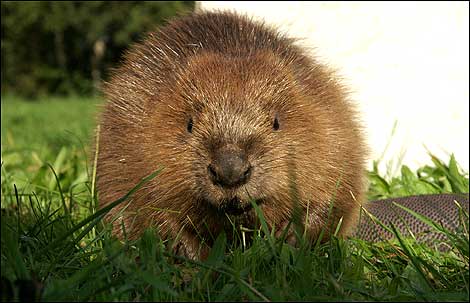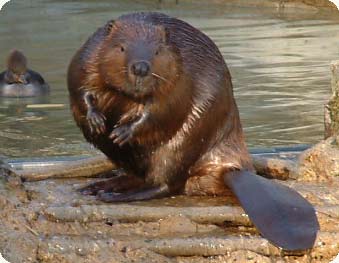 |
 |
| Baby beaver Photo: Kevin O'Hara. (BBC: Inside Out) | A beaver on the Zoo's Valley Trail. Photo: Stephanie Garnett/FONZ (Zoogoer) |
Department of English
Faculty of Arts, Chulalongkorn University
2202124 Introduction to Translation
Informative Text (English-Thai) Discussion
| The translations given on this page are neither comprehensive nor definitive. They are here to give you an idea of the range of possibilities and to spark discussion. Suggestions and comments are welcome. |
Translate the following into Thai.
Beavers are more than just fascinating creatures with flat tails and lustrous fur. Their ability to change the landscape is second only to humans. As a keystone species, beavers create rich habitats for other mammals, fish, frogs and birds. They also maintain valuable wetlands that sponge up floodwaters, prevent erosion, and act as the "earth's kidneys," by purifying water. The latter occurs because several feet of silt collect upstream of older beaver dams, and such toxics as pesticides are broken down in the wetlands. Thus, the water downstream of the dams is cleaner and requires less treatment.
Wildlife conservationists find beavers to be gentle, intelligent beings fond of doing naughty things. As they breed only once a year, and two-year-olds leave home each spring to find their own territories, beavers rarely overpopulate an area. Although accidents like falling in abandoned wells claim many beavers' lives, trapping is the most common cause of death.
 |
 |
| Baby beaver Photo: Kevin O'Hara. (BBC: Inside Out) | A beaver on the Zoo's Valley Trail. Photo: Stephanie Garnett/FONZ (Zoogoer) |
|
Translation 1: Sample for Critique
ตัวบีเวอร์มีขนเป็นมันสวย หางพาย และน่าสนใจอย่างยิ่งก็จริง แต่ยังมีคุณสมบัติยิ่งไปกว่านั้น บีเวอร์เปลี่ยนแปลงสภาพแวดล้อมได้มากเป็นรองก็แต่มนุษย์เท่านั้น และยังเป็นสัตว์ชนิดหนุนนิเวศน์ หมายความว่า บีเวอร์เป็นตัวสร้างสิ่งแวดล้อมที่อยู่อาศัยที่อุดมสมบูรณ์ให้แก่สัตว์เลี้ยง ลูกด้วยนมอื่น ๆ และสัตว์จำพวกปลา กบ และนกอีกด้วย นอกจากนี้ตัวบีเวอร์ยังช่วยรักษาพื้นที่ชุ่มน้ำอันมีค่า ซึ่งเป็นเสมือนฟองน้ำคอยดูดซับกักเก็บน้ำท่าน้ำหลาก ป้องกันการกัดเซาะพังทลายของดิน และทำหน้าที่เป็นดั่งไตให้กับธรรมชาติ ช่วยกรองน้ำให้สะอาด บริเวณเหนือเขื่อนบีเวอร์ร้างจะมีตะกอนสะสมอยู่หนากว่าเมตร สารพิษต่างๆ เช่นยาปราบศัตรูพืชจะย่อยสลายไปในพื้นที่ชุ่มน้ำเหล่านี้ ดังนั้นน้ำใต้เขื่อนบีเวอร์จึงสะอาดกว่าและไม่ต้องบำบัดมากเท่าน้ำเหนือเขื่อน นักอนุรักษ์สัตว์ป่ามองว่าบีเวอร์เป็นสัตว์ฉลาด อ่อนโยน และชอบทำอะไรแผลงๆ บีเวอร์จะผสมพันธุ์เพียงปีละครั้งเท่านั้น และเมื่ออายุ ครบ 2 ปีจะออกไปหาที่อยู่ใหม่เป็นของตนเองในฤดูใบไม้ผลิ จึงไม่ค่อยมีปัญหาประชากรบีเวอร์มากเกินไปในพื้นที่ที่มันอยู่ แม้บีเวอร์จะตายเพราะอุบัติเหตุ เช่น ตกบ่อน้ำร้างตายเป็นจำนวนมาก สาเหตุการตายที่พบบ่อยที่สุดคือถูกดักจับ
|
|
Translation 2: Sample for Critique
บีเวอร์เป็นสัตว์ที่น่าสนใจอย่างยิ่ง มีหางแบนและขนเป็นเงางาม แต่ยังมีอะไรดีกว่านี้อีก บีเวอร์เปลี่ยนแปลงภูมิทัศน์ได้มากเป็นรองก็แค่มนุษย์เท่านั้น และยังเป็นสัตว์ชนิดที่สำคัญมากในระบบนิเวศน์ คือ บีเวอร์เป็นสัตว์ที่สร้างถิ่นที่อยู่อาศัยที่อุดมสมบูรณ์ให้แก่ สัตว์เลี้ยงลูกด้วยนมชนิดอื่น ๆ รวมทั้งสัตว์ชนิดปลา กบ และนกต่าง ๆ ช่วยรักษาพื้นที่ชุ่มน้ำอันมีค่าที่จะดูดซับน้ำบ่าไหลหลากไว้เหมือนฟองน้ำ ช่วยไม่ให้ดินถูกกัดกร่อน และทำหน้าที่เป็นไตให้แผ่นดินโดยทำให้น้ำสะอาด นักอนุรักษ์สัตว์ป่าเห็นว่าบีเวอร์เป็นสัตว์ที่เฉลียว ฉลาด ขี้เล่น และอ่อนโยน บีเวอร์ผสมพันธุ์เพียงปีละหนเท่านั้น และพออายุสองปีก็จะทิ้งรังในฤดูใบไม้ผลิ ไปหาอาณาเขตใหม่อยู่ จึงเป็นสัตว์ที่ไม่เพิ่มจำนวนหนาแน่นเกินไปในพื้นที่ใด แม้ว่าอุบัติเหตุจะทำให้บีเวอร์เสียชีวิตเป็นจำนวนมาก เช่น ตกบ่อบาดาลเก่า แต่ติดกับดักเป็นสาเหตุการตายอันดับหนึ่ง
|
Reference
beavers – บีเวอร์ ตัวบีเวอร์ เจ้าบีเวอร์
Mammal Fact Sheets: Beaver
American Beaver Castor canadensis
Todd Wilkinson, "The Benefits of Beavers," National Parks (2003)
taxonomy
keystone species – an animal that has a disproportionate effect on its environment relative to its biomass (Future of millions depends on conservation of Tibet’s keystone species)
wetlands
silt –
Discussion
Beavers are more than just...
ตัวบีเวอร์มีดียิ่งไปกว่าเป็น
ตัวบีเวอร์เป็นสัตว์น่าสนใจก็จริง แต่
ตัวบีเวอร์มีอะไรมากกว่าเป็นแค่
ตัวบีเวอร์ไม่ได้เป็นแค่
ตัวบีเวอร์ไม่ได้แต่เพียง
Word choice: Oftentimes an informative text will use figurative language or other vivid expressions to convey information or illustrate ideas. In your Thai translation, it is ideal if you can retain a sense of the specific diction or metaphor intended to effectively express the content of the passage. Consider how the following examples handle the illustrative language to show the functions of wetlands that beavers help preserve.
Parallelism
Ex. They also maintain valuable wetlands that sponge up floodwaters, prevent erosion, and act as the "earth's kidneys," by purifying water.
older beaver dams
"Dam" is the main noun. "Beaver" modifies "dam," telling us that these dams are made by beavers. "Older" modifies "beaver dams," telling us that these dams have been built by beavers for quite some time. That is, the dams are old, not newly built.
How Many Is "Many"?: A Sense of Quantity
Although accidents like falling in abandoned wells claim many beavers' lives, ...
Here, เป็นจำนวนมาก conveys the sense of numerous lives better than หลายตัว which sounds too few.
Vocabulary
fascinating (adj.) – น่าสนใจอย่างยิ่ง น่าสนใจมาก น่ารู้
extremely interesting (Merriam-Webster)
lustrous fur – ขนเป็นมัน ขนเป็นเงา ขนเป็นมันสวย
1: reflecting light evenly and efficiently without glitter or sparkle <a lustrous satin> <the lustrous glow of an opal>
second only to – เป็นรองแค่ เป็นรองก็แต่
2: the position in a
competition or scale that comes after the one that is the best,
most successful etc. (Longman
Dictionary of Contemporary English)
Ex. She won second prize.
Ex. They climbed to second place in the League.
second largest/most successful etc.
Ex. Africa's second highest mountain
be second only to something (= used to emphasize that
something is nearly the largest, most important etc.)
Ex. The euro will have a circulation second only to
that of the dollar.
3: next in quality or
importance after someone or something that is the best or most
important (Macmillan
Dictionary)
Ex. She was our second choice for the job.
Ex. Gloria played second violin in the school orchestra.
second only to:
Ex. In terms of scoring goals, he’s second only to
Davies.
keystone species – ชนิดพันธุ์หลัก สัตว์ที่มีความสำคัญมาก สัตว์ที่มีความสำคัญในระบบนิเวศ สัตว์ชนิดพันธุ์ที่เป็นแกนหลัก สัตว์ที่มีบทบาทเด่นในระบบนิเวศน์ สิ่งมีชีวิตที่มีความสำคัญ สัตว์พันธุ์หลักที่สำคัญ ถ้ามีชนิดนี้จะเป็นประโยชน์ต่อสิ่งอื่นมีอิทธิพลต่อความอยู่รอดของสัตว์อื่น ๆ
habitat – ถิ่นที่อยู่ ถิ่นอาศัย ถิ่นที่อยู่อาศัย ที่อยู่อาศัย
mammals – สัตว์เลี้ยงลูกด้วยนม
maintain – รักษา รักษาสภาพ รักษาให้คงอยู่
wetlands – พื้นที่ชุ่มน้ำ บึง หนอง พรุ
floodwaters – น้ำบ่า น้ำท่า น้ำหลาก
erosion – การกัดกร่อน การกัดเซาะ การพังทลาย การกัดกร่อน สึก กร่อน กษัยการ การชะล้างพังทลายของดิน
upstream of the dam – เหนือเขื่อน หลังเขื่อน
upstream –
1: moving or situated in the opposite direction from that in which a stream or river flows; nearer to the source (Oxford Dictionaries Online)
1: in the direction opposite to the flow of a stream (Merriam-Webster)
downstream of the dam – ใต้เขื่อน หน้าเขื่อน
downstream –
1: situated or moving in the direction in which a stream or river flows (Oxford Dictionaries Online)
Ex. [as adverb] The bridge spanned the river just downstream of the rail line.
Ex. [as adjective] Deforestation could have disastrous consequences for downstream regions.
1: in the direction of or nearer to the mouth of a stream (Merriam-Webster)
dam – เขื่อน ฝาย ทำนบ
treat (v.) – บำบัด
find – เห็นว่า มองว่า (Oxford Dictionaries Online)
2: identify (something) as being present
Ex. Vitamin B12 is found in dairy products.
วิตามิน บี12 มีในอาหารประเภทนม
Ex. [...] a rare species found only in the Italian Alps.
หายากชนิดนี้มีอยู่แต่ที่เทือกเขา แอลป์ในประเทศอิตาลี
2a: experience to be the case
Ex. [with object and infinitive] The majority of staff find the magazine to be informative and useful.
พนักงานส่วนใหญ่เห็นว่านิตยสารนี้ให้ ความรู้และเป็นประโยชน์ดี
gentle – อ่อนโยน ไม่ดุร้าย
2a: tractable, docile b: free from harshness, sternness, or violence (Merriam-Webster)
fond of doing naughty things – ชอบทำอะไรแผลงๆ ชอบแกล้ง ชอบทำอะไรที่ไม่ควรทำหรือไม่ถูกต้อง
breed (v.) – ผสมพันธุ์
territory – อาณาเขต พื้นที่ ที่อยู่
well (n.) – บ่อน้ำ บ่อน้ำใช้ บ่อน้ำบาดาล บ่อน้ำใต้ดิน
Source
(N. American:
Castor canadensis)
(Eurasian: Castor fiber)
Beavers are more than intriguing animals with flat tails and lustrous fur.
American Indians called the beaver the "sacred center" of the land because
this species creates such rich, watery habitat for other mammals, fish,
turtles, frogs, birds and ducks. We now know that beaver damming provides
essential natural services for people too.
Beavers prefer to dam streams in shallow valleys, where the flooded area
becomes productive wetlands.These cradles of life support biodiversity
that rivals tropical rain forests. Almost half of endangered and
threatened species in North America rely upon wetlands. Freshwater
wetlands have been rated as the world's most valuable land-based
ecosystem.
Beavers reliably and economically maintain wetlands that sponge up
floodwaters, alleviate droughts and floods (because their dams keep water
on the land longer), lesson erosion, raise the water table and act as the
"earth's kidneys" to purify water. The latter occurs because several feet
of silt collect upstream of older beaver dams, and toxics, such as
pesticides, are broken down by microbes in the wetlands that beavers
create. Thus, water downstream of dams is cleaner and requires less
treatment for human use.
A Bit About Beavers
Beavers' ability to change the landscape is second only to humans. That is
just one reason why we find the flat-tailed species fascinating. While
some beaver behavior is instinctive, they also learn by imitation and from
experience. Dr. Donald Griffin, the father of animal cognition, has said,
"When we think of the kinds of animal behavior that suggest conscious
thinking, the beaver comes naturally to mind."
Wildlife rehabilitators find beavers to be gentle, reasoning beings who
enjoy playing practical jokes. An Indian word for "beaver-like" also means
"affable." Adults may weigh over 40 pounds, and beavers mate for life
during their third year. Both parents care for the kits (usually one to
four) that are born in the spring. The youngsters normally stay with their
parents for two years, and the yearlings become babysitters for the new
litter. After weaning, their favorite foods include water lily tubers,
apples and the leaves and green bark (cambium) from aspen and other
fast-growing trees. Tree cutting is part of nature's cycle, and beaver
pruning stimulates willows, cottonwood and aspen to regrow bushier than
ever the next spring. After eating, beavers use the peeled sticks to build
a teepee-like lodge on the shore and/or a dam.
By damming streams, beavers often raise the water level to surround their
lodge with a protective moat, and create the deep water needed for winter
food storage in northern climes. While other wildlife endure wintertime
cold and hunger, beavers stay warm in their lodges with an underwater food
cache of branches nearby. A beaver colony, can consist of six or more,
including parents, yearlings and kits, yet they peacefully coexist in a
lodge with underwater access to the iced-up pond for four months or more
in the North.
Natural
Population Control
Beavers rarely overpopulate because they breed only once a year, defend
large streamside territories from strangers, and the two-year-olds leave
home each spring to find mates. They are limited to a small fraction of
the landscape that is close to waterways. Kits have many predators
including hawks, owls and otters. Bears, wolves, dogs and coyotes will
also take older beavers that are especially vulnerable when seeking new
territories. Accidents are another frequent cause of mortality, including
falls into abandoned wells, and especially traffic accidents. Trapping is
the most common source of mortality.
Beavers have fewer kits when occupancy reaches a certain level and food
becomes scarce. In vast areas without trapping, beaver populations will
peak, and then slowly drift down to a sustainable level. Removing beavers
stimulates larger litters from survivors in the area.
By the early 1900s, beavers were almost extirpated from North America,
Europe and Asia due to trapping and the subsequent draining of lands for
agriculture. Estimates of the current N. A. population are as low as five
percent of those present prior to European settlement. When conflicts with
humans arise, using modern methods can provide lasting solutions.
Links
Other Beaver Stories
Amy Himes, "At the Zoo: Busy Beavers," Zoogoer (2002)
Other Dam Stories
ภาพ จากดาวเทียมเปรียบเทียบสภาพลำน้ำโขงระหว่างการสร้างเขื่อนและหลัง เขื่อนเสร็จ ในสาธารณรัฐประชาชนจีน
Home | Introduction to Translation
Last updated March 9, 2021